This is a story about how three very different individuals were involved in the return of the Papacy to Italy in the 14th Century.
In my article about the Avignon “captivity” I talked about how the French King basically took over the Papacy, moved it to Avignon in Provence, and stacked it with Frenchmen. Now I am going to talk about its return to Rome, almost 70 years later. It’s a complicated story, which I propose to simplify by concentrating on three people, only one of whom – Saint Catherine of Siena – was Italian. The other two are a Spaniard and an Englishman. Gosh, where do I start?
Catherine of Siena
Let us start with Catherine, whom history has long credited with being a major force in pressuring the last Avignonese Pope (Gregory XI) to return with his curia to Rome. Apparently modern scholarly opinion varies on just how influential she was, but as we shall see, she had by then acquired a reputation for holiness. Giving her the credit might therefore have been a deliberate move – listening to a saintly person would have been a more acceptable story than acknowledging some of the more worldly considerations Gregory might have had.
Catherine (her full name was Caterina di Jacopo di Benincasa) was born in Siena in 1347, just before the Black Death struck Europe. Her father was a cloth dyer and must have been reasonably well-off, going by the size of the house in which Catherine lived with her long-suffering family, and which you can still visit.
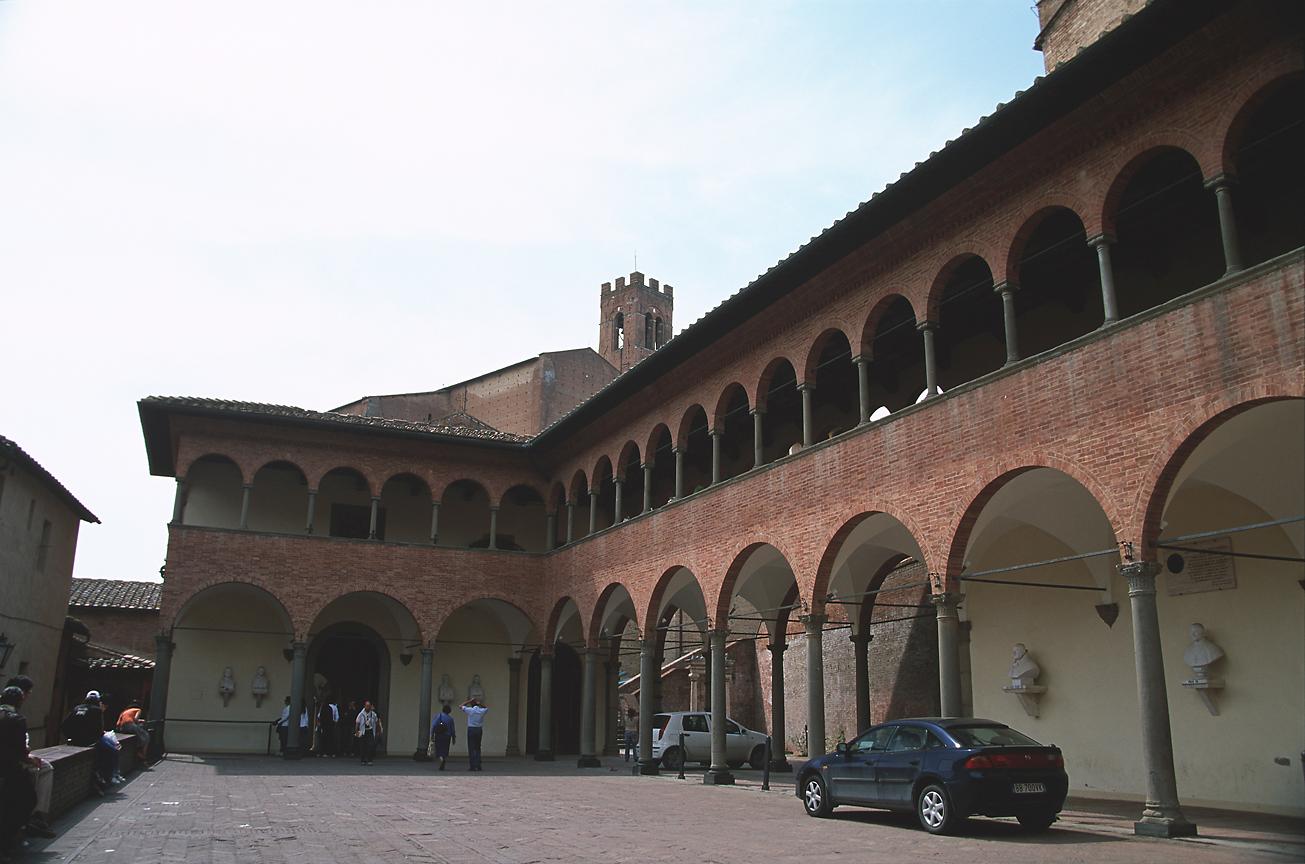
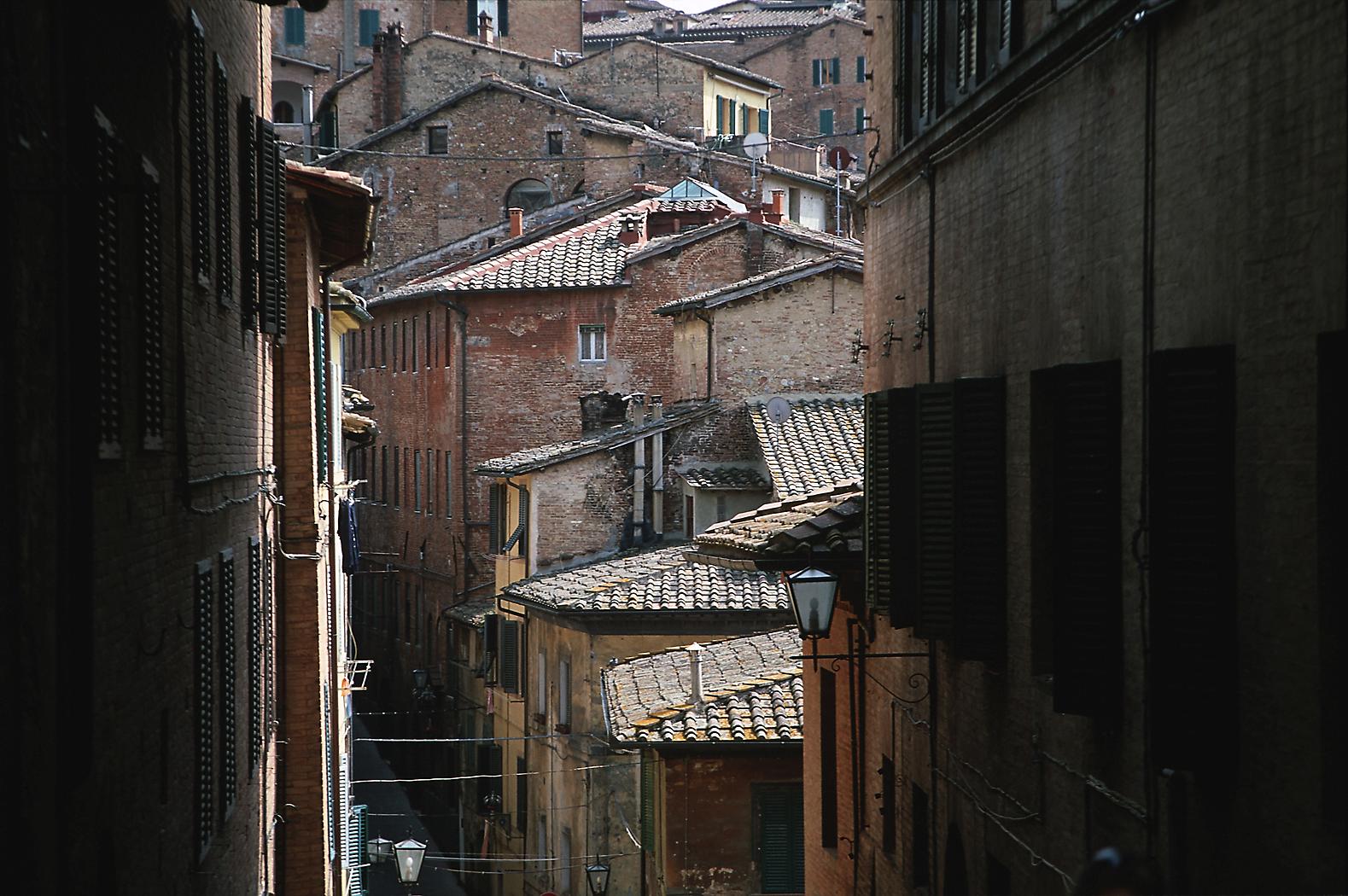
Catherine is known, among other things, for some fairly extravagant acts of asceticism and mortification of the flesh, some with psycho-sexual overtones, that today would provide plenty of material for a doctoral thesis in forensic psychology, or at the very least a conference paper. At a minimum she would be diagnosed with anorexia. But we must be careful not to judge the past too much by the standards of the post-Freudian present, at least not without trying to understand what it must have been like to live then. During her childhood, the plague killed more than half the population of Europe – and an even greater proportion of the population in crowded medieval Italian cities. I have seen one reference to over three-quarters of the population of Siena having died. You can still see the effects today – in 1339 Siena had started a significant project to enlarge the cathedral, which stopped during the plague and never restarted.
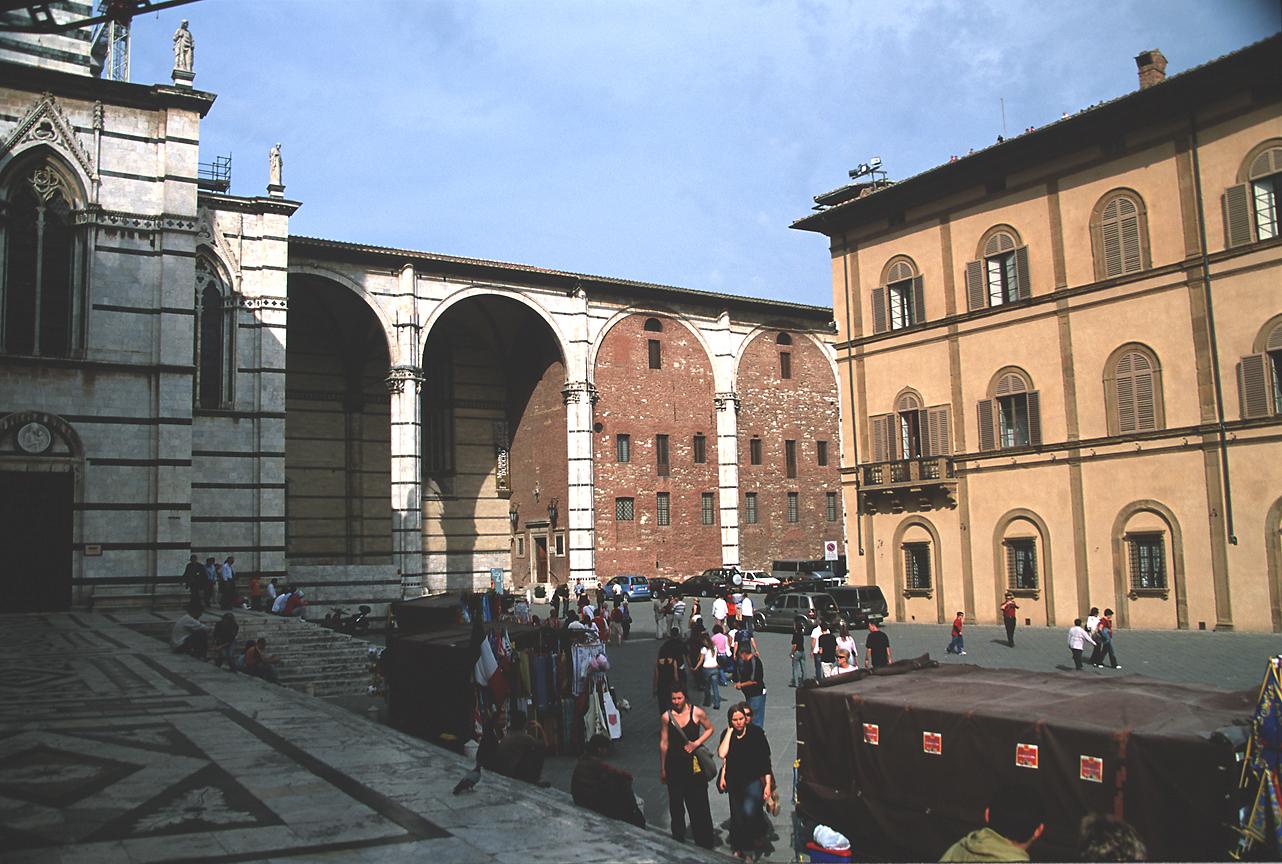
In the absence of any scientific understanding of what had caused the catastrophe, it is hardly surprising that many people assumed they were living through the early chapters of the Apocalypse, and responded accordingly. Confraternities of flagellants paraded through the streets whipping themselves. Others thought about prophecies of false saviours and false preachers, and looked hard at the contemporary church, obsessed as it was with wealth and power. This was the world in which the young Catherine grew up; how could it not have affected her and her contemporaries?
Although she is often portrayed in the habit of a Dominican nun, it seems that she was probably not a nun but joined a lay sisterhood associated with the Dominicans. Given the considerable freedom she seemed to enjoy, including living at home with her family, and travelling around Italy urging clerical reform, it does seem more likely that she was not actually a nun. Either way, she lived a life of virgin piety, acquired a reputation for holiness, and a habit of dictating letters to popes and princes telling them what they ought to be doing (the lay sisterhood taught her to read, but the fact that her books and letters were all dictated suggests that she did not write).
One of her lucky targets was Pope Gregory, who received a series of letters arguing for the return of the Papacy to Rome, and for reforms to the Church and the Papal States. John Julius Norwich, in his book The Popes, suggests that Gregory had already decided that the Papacy belonged in Rome, but as Catherine’s fame spread, associating her with the cause would have been an astute move. Gregory, like the rest of the Papal court, was French, but many of his fellow-Frenchmen did not share his enthusiasm for Italy, so he would have needed to make it look like he was yielding to a mass movement.
Her body worn out by self-inflicted privations, Catherine died in 1380 aged just 33, but she was quickly canonised, adding yet further spiritual lustre to the return-to-Rome movement. Another woman who had agitated for a return to Rome – Bridget of Sweden – was canonised as well, suggesting that the Papacy had no objections to such advocacy.
Cardinal Gil Albornoz
Gregory was not the first Avignon Pope to contemplate a return to Rome. Fifteen years or so earlier Innocent VI had the same idea, but he faced a problem, not with the Papacy’s spiritual power, but with its secular power in Italy, which had attenuated during the time in Avignon. The Popes’ claims to secular sovereignty were based on a bare-faced and not very competent 9th-Century forgery known as “The Donation of Constantine” according to which the Emperor Constantine had rather implausibly handed over the entire Western Empire, including Italy, to the Pope to rule as sovereign territory. In practice, the Papal power to govern states only really ran until it encountered a stronger power: in the North, the Holy Roman Empire, in the South, the Normans followed by the Angevins and Spanish, and in the West, Spain and of course France.
In much of Europe the Middle Ages saw the growth of unitary states with all powers vested in monarchs. In contrast, Central and Northern Italy saw the emergence of independent communes in which towns and cities developed the institutions of government for themselves, and an admirable system (rule by an independent podestà appointed from another city for a fixed term) to keep them working.
Over time the communes failed and became counties and dukedoms, or the notionally independent institutions remained in place but effective government took place behind the scenes under the control of powerful families like the Medici.
In the longer term the future for Italian cities was either direct control from Rome or passing into the possession of a foreign dynasty, but back in the 14th Century none of that looked inevitable. The Visconti of Milan were growing in power and many other cities were quite content with the de facto independence they enjoyed with the Papacy all that distance away in Provence. Two things turned all that around – one was the Black Death, which temporarily stopped all economic activity and created a significant labour shortage. The other was Cardinal Gil Àlvarez Carrillo de Albornoz, the Pope’s Vicar-General.
In theory the Vicar-General was a cardinal delegated to assist the Pope with the management of the Papal States, but as Vicar-General, Albonorz was more of a general than a vicar. An example of the church militant if ever there was one, Albornoz led armies, besieged cities, killed thousands, and built a lot of fortresses in the process of completing his task to re-establish Papal control.
He had started his career as a mere archbishop of Toledo leading his forces in Spain against invaders from Morocco. Without apparent ironic intent, Innocent VI gave him the title “Angel of Peace”.
So in 1353 Albornoz was given the job of subduing these independently-minded city-states, and he and his small army of mercenaries turned out to be very effective at it.
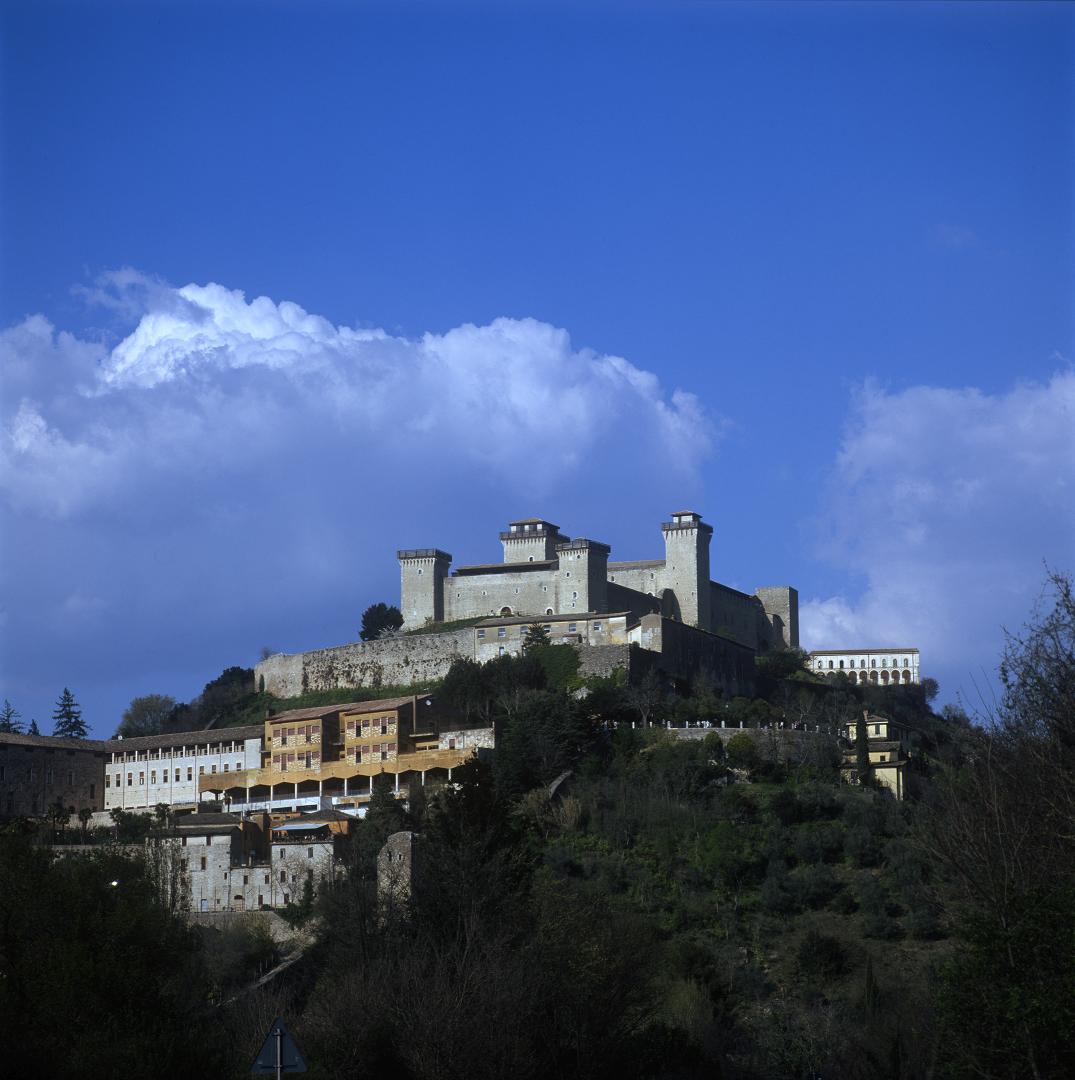
All through central Italy, in towns like Urbino, Assisi, Orvieto, Spoleto and Narni, you will find castles built by Albornoz after the towns were taken by Papal forces. In other towns such as Todi you might find the remains of one subsequently dismantled. The name and the history behind them are well enough known that they may simply called “Fortezza Albornoz” or “Rocca Albornoz”.
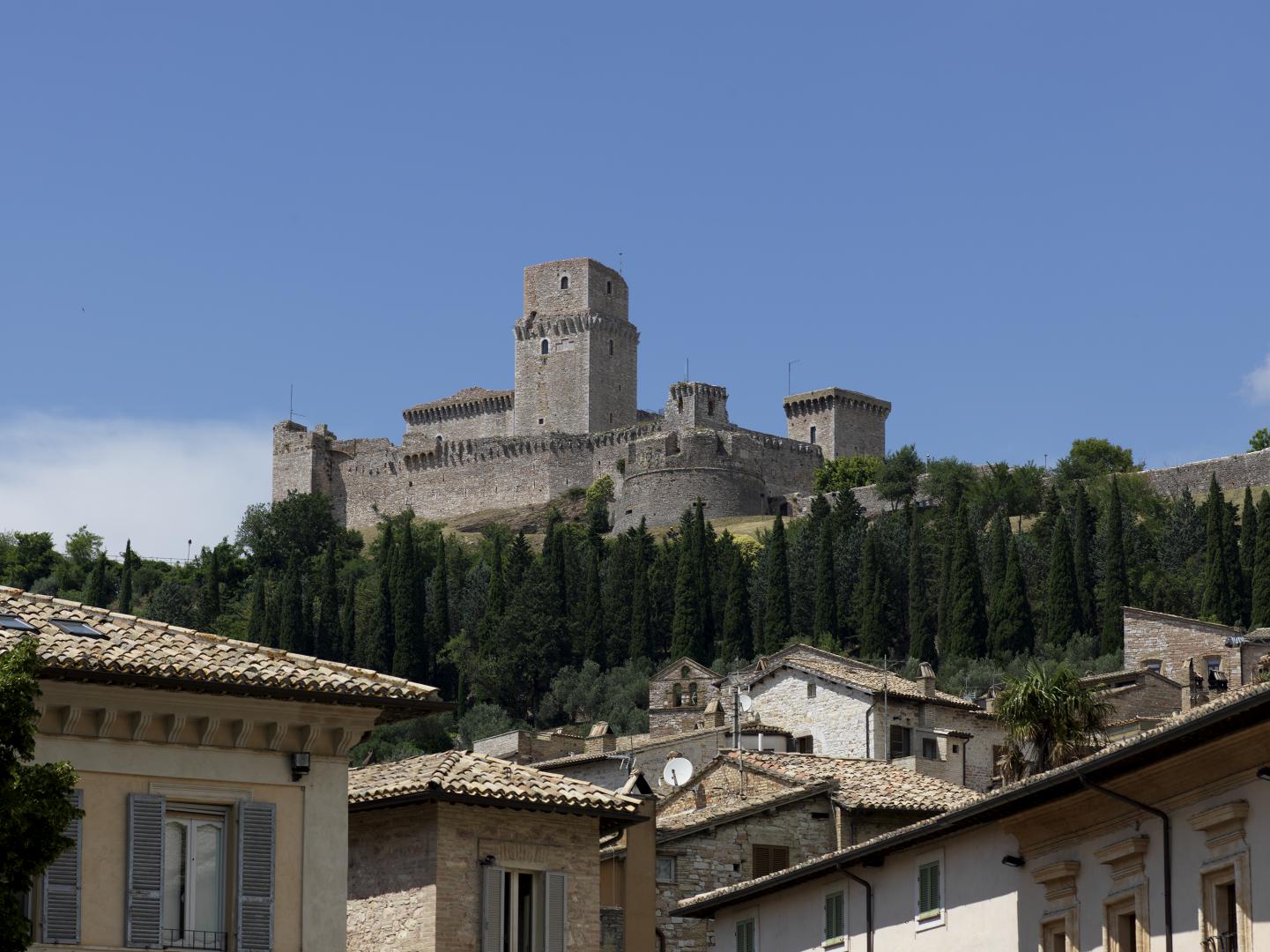
Under Albornoz, the role of these fortresses was not to defend the towns they guarded. It was to subdue them, and in cases like Narni, it was to control a strategic road – the ancient Via Flaminia where it passes through the gorge of the River Nera.
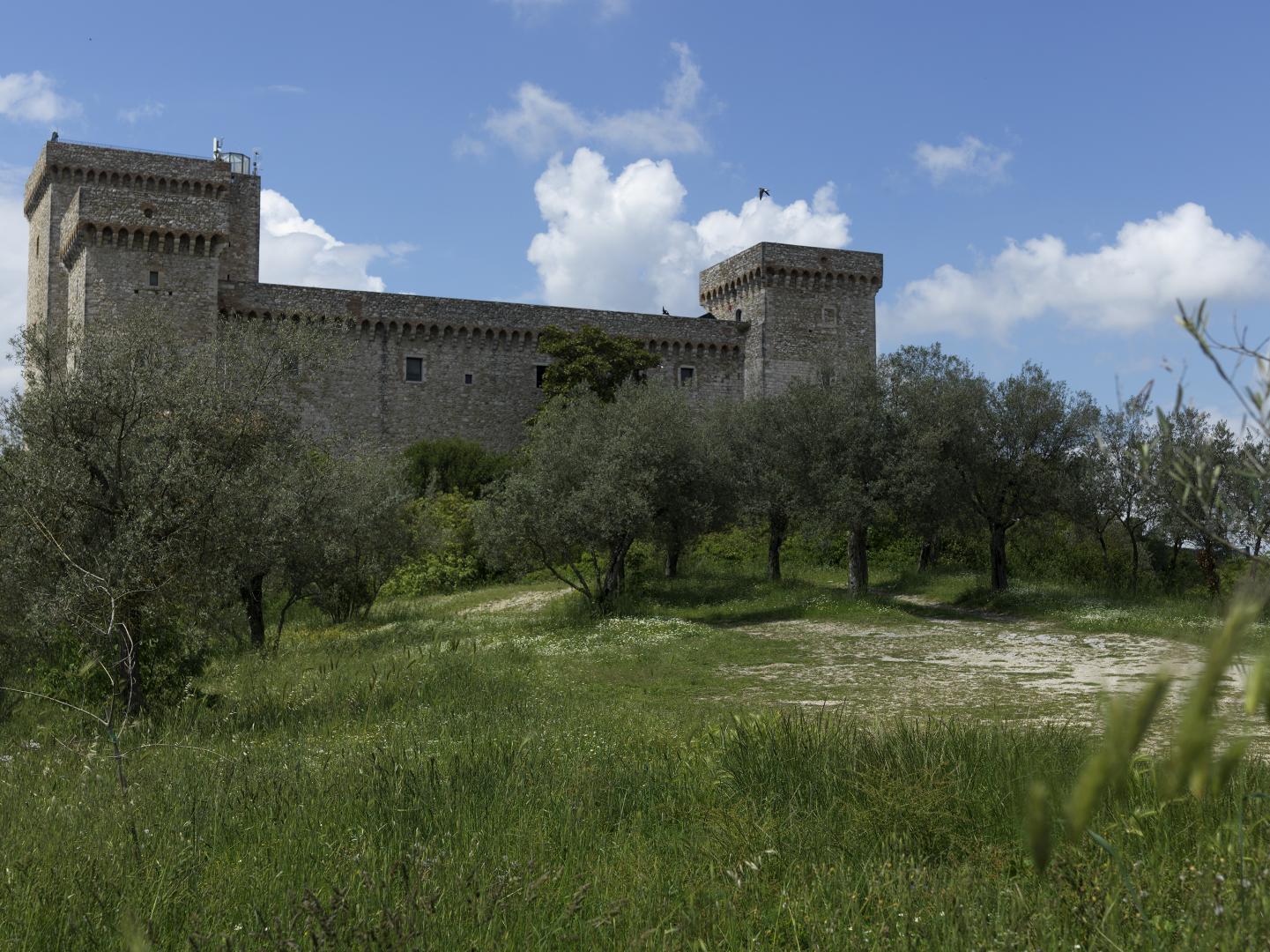
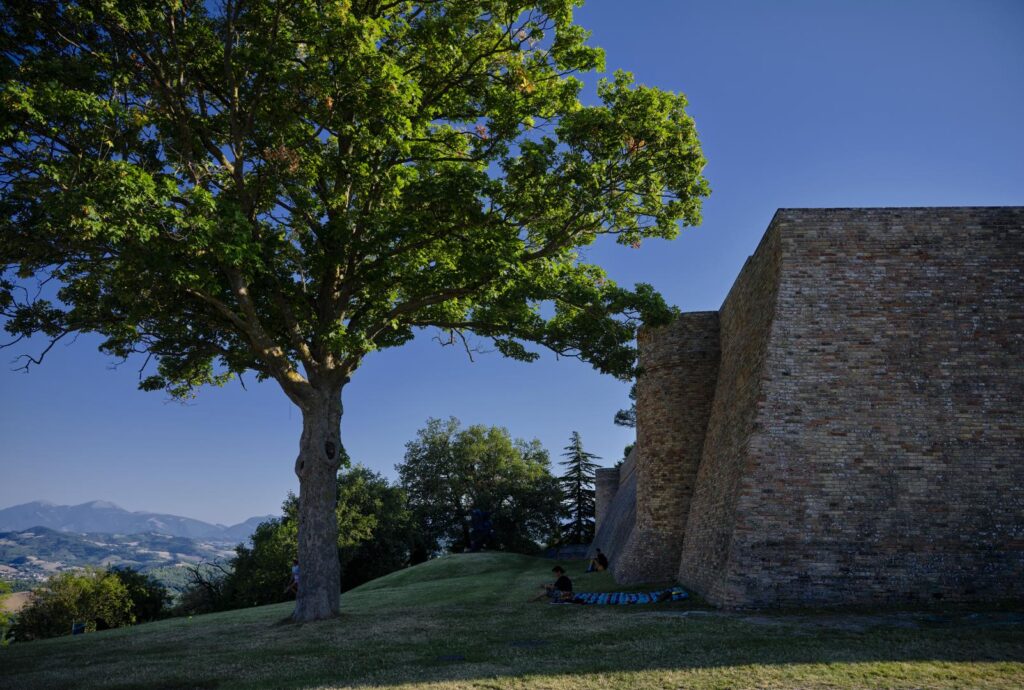
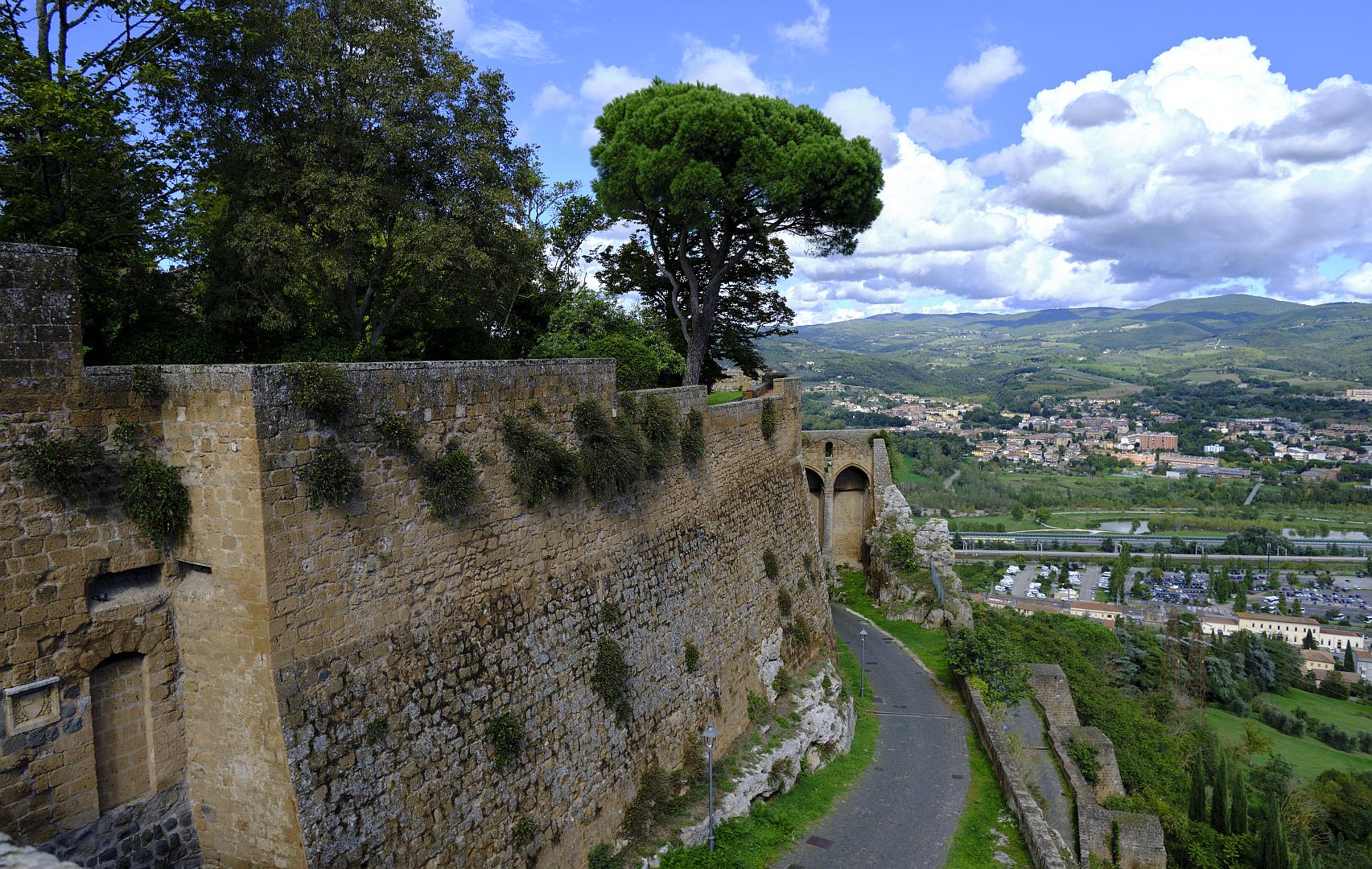
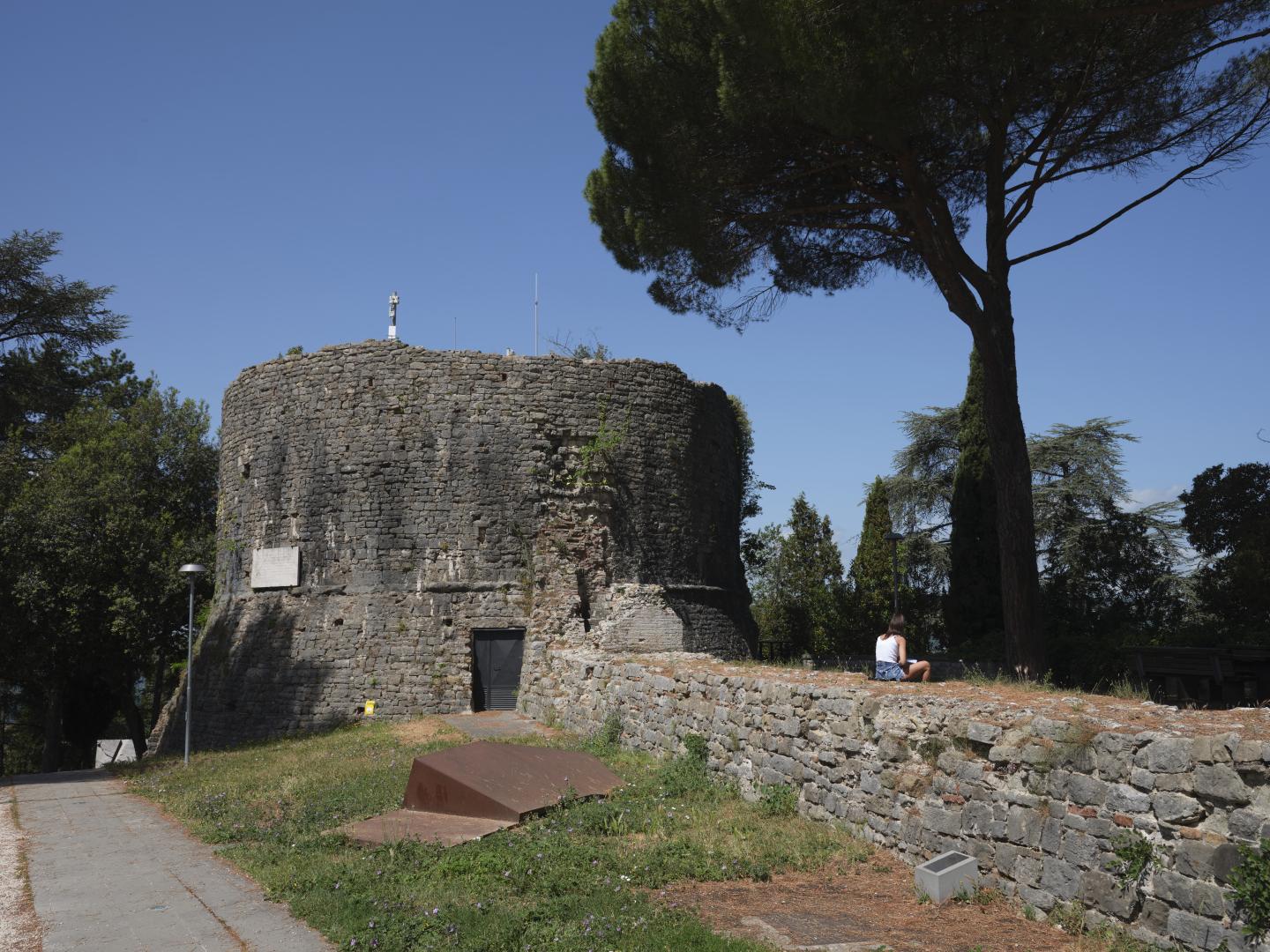
But now we need to turn our attention to the third person in this story – and one just as unlikely as the other two.
Sir John Hawkwood
Some people say that “Hawkwood” sounds like the name of a character from a fantasy novel, but it makes me think of a 1970s prog-rock band. I’ve just discovered that there is also a character by that name in a popular video game. Whatever associations his name might have for English speakers, the Italians couldn’t really cope with it and mangled it into “Giovanni Acuto”, which since that means “John the Sharp” or “John the Astute”, is not actually a bad fit. It turns out that Albornoz wasn’t the only person leading a band of mercenaries around Italy, and that this particular person – Hawkwood – had a considerable effect, for good or ill, on the conduct of warfare and politics in Italy. He was loathed and execrated, but ended up being celebrated as a hero in Florence.
How did an Englishman find himself in that position? It was in part the unintended consequence of a peacemaking exercise by a Pope. In 1360 the Hundred Years’ War between England and France was still only the Twenty-Three Years’ War, but after the disasters of Crécy and Poitiers, and the taking into captivity of the French King, things were going badly for France. Innocent VI (like all the other Avignon Popes a Frenchman) had been keen to engineer a truce, which he did with the Treaty of Brétigny.
The unintended consequence of peace was that, because a large number of troops on both sides were not feudal levies but mercenaries, they were promptly discharged in situ in France, either to starve or to form themselves into “free companies” and keep on soldiering, but this time on their own account. One such group was called the White Company, led by a German called Sterz, but composed mostly of Englishmen, including John Hawkwood of Essex.
Pickings were slim in the war-ravaged regions of north-western France, but to the south was a fabulously wealthy place – the Papal state of Avignon. The brigands captured the nearby town of Pont-Saint-Esprit and laid siege to Avignon itself. After a while, and another outbreak of plague, Innocent gave in and paid them a large sum of money to go away. And here’s a fascinating possibility. There is no written record, it seems, of the agreement between the Papacy and the White Company, but it has been suggested that part of the deal was that the Company should continue south into Italy, there to assist Albornoz, who already had several mercenary companies in his pay. Subsequent events are not inconsistent with this scenario.
The free companies hit Italy like a gauntleted fist. Italy had seen a good many armies over the years, but the military professionalism of these foreigners set them apart from the citizen militias that were all that most cities could call on – to the amazement of Italians, they even continued campaigning in winter. And they had the English longbow – the most effective infantry weapon of the Middle Ages.
While working for Perugia, Sterz was imprisoned and executed by the city authorities on a charge of plotting to betray them to the Papal forces, and Hawkwood formally took over command of the White Company. He quickly established a reputation for ruthless effectiveness – you wanted him on your side if you could afford him. And there were plenty who could, or were desperate enough to promise to find the money. Central and northern Italy were in turmoil as Albornoz, the Visconti of Milan and the remaining free communes all manoeuvred for advantage. At this early stage Hawkwood was mostly fighting on the side of the Pope, but on one occasion when he was not, he had a mysterious and bloodless encounter with Albornoz’s forces near Orvieto which may simply have been arranged to create an opportunity for a clandestine meeting between the two.
Hawkwood fought on the Pisan side in an inconclusive Pisa-Florence war, on the Milanese side in a war between the Visconti and Papal forces, and on the Papal side in two wars with Florence. He built closer relations with Milan, marrying Donnina Visconti, the illegitimate daughter of Bernabò Visconti, the Lord of Milan. It seems she had inherited her father’s force of character and proved an effective deputy in managing Hawkwood’s affairs.
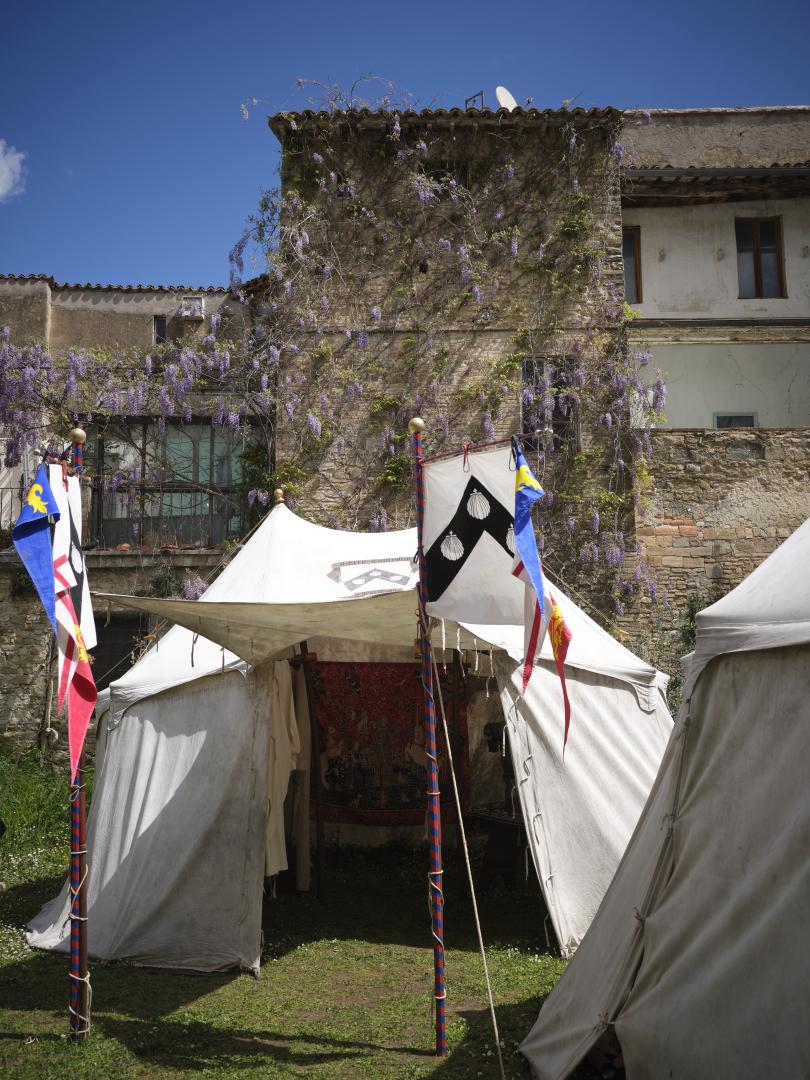
Pope Innocent died and was replaced by Gregory XI. Albornoz died on campaign and was replaced as Vicar-General by Cardinal Robert of Geneva, a vicious man who in the name of the Church perpetrated one of the worst massacres of the Italian Middle Ages, in which most of the population of Cesena were slaughtered, despite having been promised forgiveness if they surrendered.
Hawkwood’s troops were involved in that massacre; by one contemporary account he tried to persuade Robert to accept the town’s submission without bloodshed, but the cardinal was determined to make an example of Cesena, and thousands of innocent civilians died.
We don’t know whether that was the event that finally turned Hawkwood against the Pope; after all he had not previously shown himself to be particularly sentimental when it came to civilian lives, and there had been other irritants in the relationship, such as Gregory’s regular failure to pay wages. That was not a trivial matter, as Hawkwood still had to pay his men out of his own pocket, causing some serious liquidity problems. On one occasion Hawkwood, in frustration, took the Umbrian town of Città di Castello in the name of the Pope but held it for himself in lieu of wages. But whatever his reasons, after the Cesena massacre Hawkwood mostly turned up on the side of a city for whom he had previously been a nemesis – Florence – and against both of his previous allies: the Visconti and the Papacy.
Florence returned the compliment: they paid him well and granted him Florentine citizenship, and he acquired a good deal of property in the region.
He died peacefully in 1394, at the (for then) advanced age of 70 or 71. The Florentine authorities gave him a lavish funeral in the duomo, where his standards were hung and remained for years. A marble tomb was planned, but the municipal funds were a bit low (perhaps because of all the money paid to mercenaries), and forty years later the Medici employed the painter Uccello to do a mock-marble memorial in the duomo, which you can still see today.
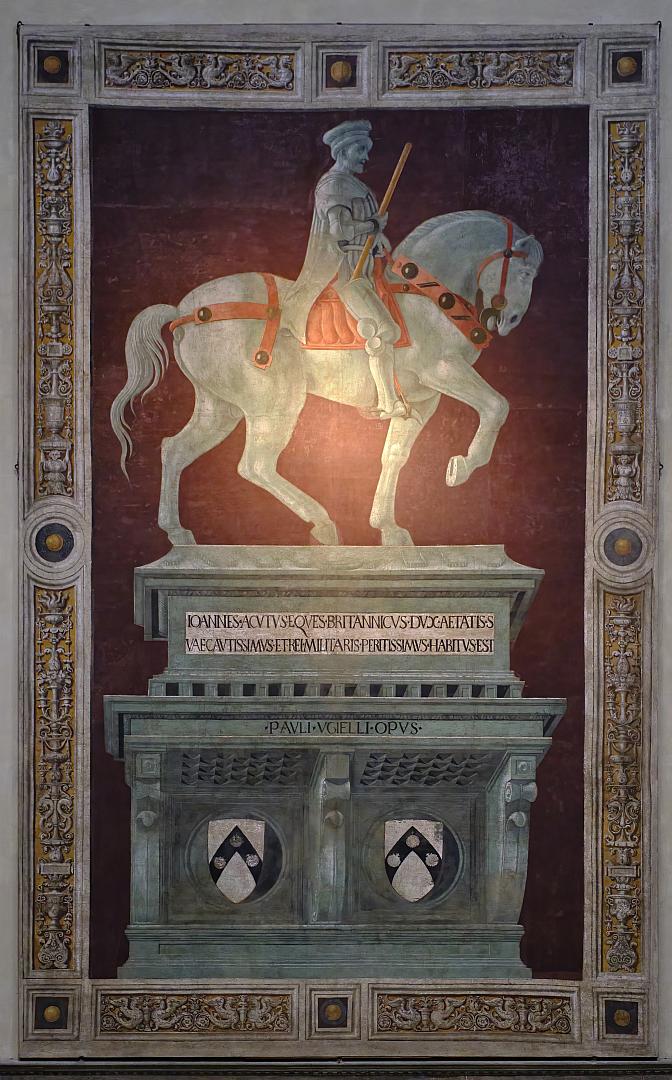
The inscription reads, in translation: “John Hawkwood, British knight, most prudent leader of his age and most expert in the art of war”.
Why would the Medici bother honouring the memory of someone forty years dead? I doubt they ever did anything out of sentiment. My guess is that it was because Hawkwood ended up on their side against dangerous rivals that still threatened them. A reminder of past victories would be a useful signal to their enemies and their own people of their determination to continue to fight for their independence.
Which brings me to the issue of Hawkwood’s legacy. Much has been written about the great and undeniable harms that the free companies visited upon Italy (although they didn’t really start any wars, they just made existing conflicts worse). And also how much the great condottieri of the next couple of centuries – Gattamelata, Colleoni, the Dukes of Mantua, Federico da Montefeltro, Cesare Borgia – learned from Hawkwood’s example. But did he do any good? The Florentines seemed to think so. Perhaps if had not been for him, Florence and Tuscany might have ended up subject to either Milan or the Papal States, or divided between them. The glories of Medici Florence might never have happened. Now that would have made a difference.
Odds and ends
In 1377, after an arduous and dangerous sea voyage from Marseilles, a small fleet carrying Gregory XI, his cardinals and his court sailed into the Tiber, and the Papacy never left Rome again. It had only been away for seven decades or so, but an awful lot had changed. The Black Death had delivered enormous economic and spiritual shocks to European society, and there was a new breath of intellectual enquiry in the air: the Renaissance was coming.
The end of the Avignon Papacy was not a clean break. Most of the cardinals were still French and shortly after Gregory died and was replaced by the Italian Urban VI, they had second thoughts, walked out, and elected their own Pope – none other than Robert of Geneva, the butcher of Cesena, who took the name of Clement VII. Urban and Clement excommunicated each other, exchanged insults, and the resulting “Great Schism of the West” was to last another forty years. Urban is now considered a canonical pope by the church, and Clement an “antipope”, which serves him right.
I’ve chosen to write this post around three individuals, but there was a fourth memorable character involved – an extraordinary fellow called Cola di Rienzo (or Rienzi). This vain and pompous, but romantic and audacious adventurer rose from humble origins, seized power in Rome, and announced his intention to reunite Italy under a reborn Roman Empire. His bombastic personality, his imperial Roman fantasies and not least his violent end are all strangely reminiscent of Benito Mussolini. It’s quite a story, which has inspired multiple works of fiction and a Wagner opera. If I can assemble enough relevant photographs I might do a separate post on him one day. (Edit: here is that post).
The White Company included not just soldiers, but lawyers and notaries as well, to draw up complex contracts with employers. One oddity of those contracts is a standard clause that they would not act contrary to their loyalty to the King of England. Some have taken this to imply a degree of control by the King (Edward III).
There is some evidence for this. Hawkwood may have been a go-between helping arrange the marriage of Edward’s second son, Lionel, Duke of Clarence, to the daughter of Galeazzo Visconti of Milan. The wedding went ahead, but Lionel died soon after (inevitably, given the Visconti’s record, there were suggestions of poison). The wedding had taken place in Milan, and the Visconti hired a large force of mercenaries to escort the groom there. That bodyguard was commanded by John Hawkwood.
In Lionel’s retinue was a young diplomat called Geoffrey Chaucer. It is probable that he and Hawkwood met, and plausible that the Knight in the Canterbury Tales is based on Hawkwood, at least in part.
Further Reading
Many histories deal with the Avignon Papacy, but an excellent start would be The Popes by John Julius Norwich, 2011.
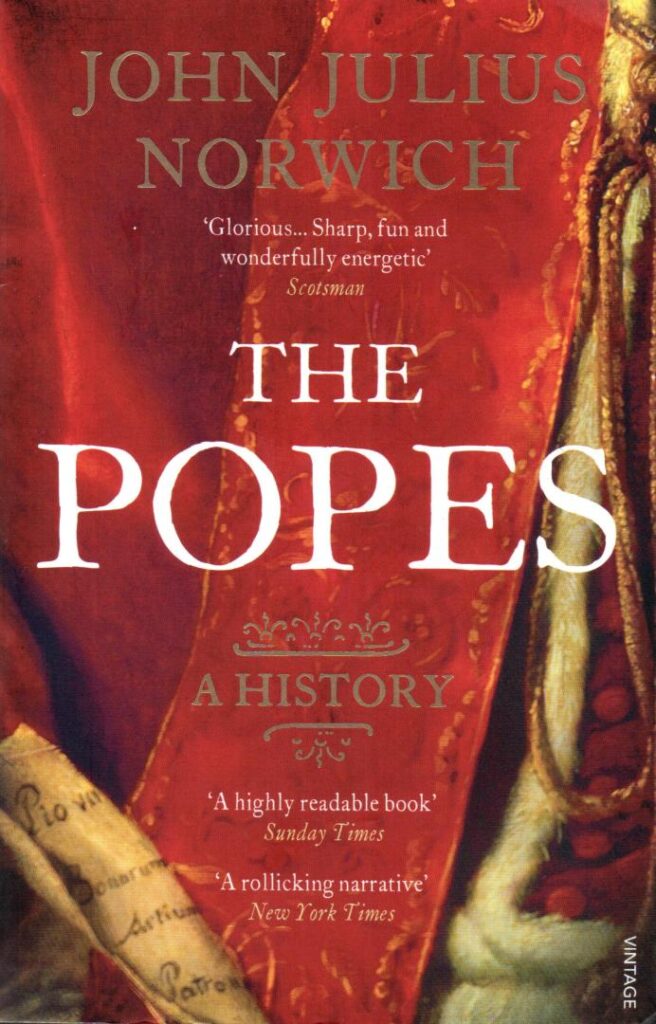
Quite a bit has been written about Hawkwood, including several works of fiction (starting with Arthur Conan Doyle). An approachable but well-researched history is Hawkwood, Diabolical Englishman, by Frances Stonor Saunders, 2004.

And for anyone who like me is not a professional historian but who wants to understand the profound traumas of the 14th Century, I think that you still can’t go past Barbara W. Tuchman’s A Distant Mirror, The Calamitous 14th Century (1978).
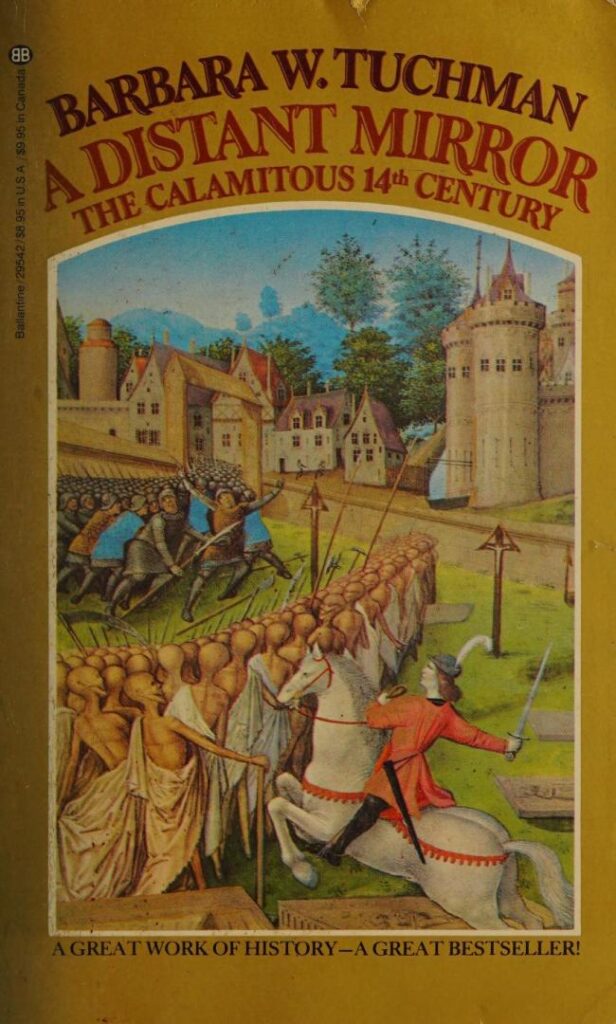

5 Replies to “Catherine of Siena, Cardinal Albornoz and Sir John Hawkwood”